(January 1930, 20m) Director: James Parrott Released: MGM, March 20, 1930 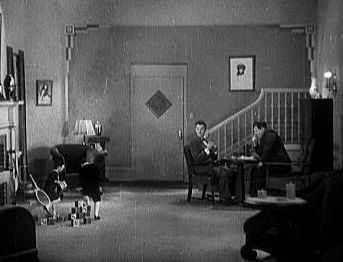 A significant step forward in the comedy of Laurel and Hardy, as large scale sets are used to create the illusion of the actors as their own sons. Not only that, but this is the point where Stan not only starts to find a wider range to his voice, but becomes written as a character that says, as well as does, funny things. Perhaps the first ever 'Stanism' caught on film is here, with the memorable 'Remember the old adage: "you can take a horse to water, but a pencil must be lead."' A lesser film would have relied upon the central conceit to sell itself, but the twenty minutes of screentime are also crammed with sight gags, such as a disastrous game of pool between Stan and Ollie, and the first chance for English audiences to hear Hardy's charming tenor voice. There's even more of the series' occasional predilection with cartoon animal protagonists (last seen with a cartoon bird that destroys a house in The Finishing Touch) as a bizarre animated mouse adds to the surrealism on display. Yet despite the sheer amount of ideas and innovation behind the short, its value as comedy is purely subjective. Having Laurel and Hardy as two grown men suffering physical pain may be one thing, but as children quite another; the appearance of the men as small children also strangely unnerving. As author Simon Louvish described it in his book Stan and Ollie: The Roots of Comedy, the entire affair can be to some 'an unsettling experience, more Dada than Daddy.' In truth, it's another of Stan's fascinations with bodily distortion and identity, an eerie concept made flesh. While it's also tempting to heap much praise on the production and the innovation of those involved, the minimal usage of split-screen isn't as groundbreaking as one might think for 1930. Split-screen had, after a fashion, been used as early as 1903 for the one reel Life of an American Fireman and Buster Keaton had used the technique to play all members of an audience, an orchestra and a minstrel troupe in 1921's tour-de-force The Playhouse. This is not to criticise Laurel and Hardy, but just to acknowledge that there was a difference between two very successful and amusing mainstream comedians of the day and people who were genuine experimental auteurs. Whatever your take on the subject matter, though, there's little denying that Brats is an extremely well-made entry that sees them pushing the boundaries of their personal art.     (February/March 1930, 20m) Director: James Parrott Released: MGM, April 26, 1930 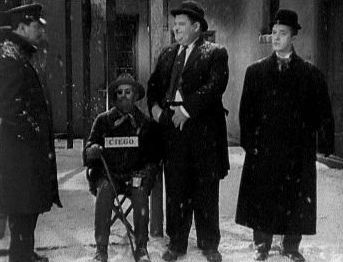 Below Zero features Stan and Ollie as two down-on-their luck musicians, unable to even eat. Over the course of the two-reeler they get their instruments smashed, falsely accused of pick-pocketing and beaten up before being left in the freezing cold streets. Laurel and Hardy weren't Chaplin and didn't go in for social commentary, but this heartbreakingly bleak look at their lives under the Depression comes close. Stan goes in for more body horror humour, ending the film with a freakish swollen belly and a toilet gag, and there's also some fun at the expense of the deaf, the dumb and the blind. Yet one thing that their oppressively brutal environment produces is confirmation of genuine friendship. Before this we've seen Hardy bully Stan and wonder just how much he genuinely cares for the friend who always succeeds in making his life worse. Yet here, when lying beaten on the street and believing Stan to still be trapped inside a hostile caf�, Hardy picks up a weapon and attempts to break the door down, risking his life for his friend. It's an oddly touching moment in an unusually harrowing film. The Spanish version of the short, Tiembla y Titubea, is most notable for its longer running time than the original, lasting an extra reel. This includes an inessential opening scene between the policeman and his superior, but also a nice bit of business where Ollie finds himself inadvertently stealing from a blind man's collection tin. Yet most notable is that the version made for the Spanish market has more violent overtones than the original, with the cop (played by Robert O'Connor instead of Frank Holliday) firing two shots after the robber, and the robber firing two back, instead of the original's innocuous 'Get outta here! Beat it!' This also leads to a reworking of their trademark 'wrong hats' routine, where all three have their hats blown off by the robber's gunfire and get involved in a three-way hat mix-up. Similarly, while the English-speaking restaurant has a man switching out the lights before Stan and Ollie's beating, in the Spanish version we get to see five henchmen, one flexing his fists, another with a knife, and a third brandishing a bottle. In terms of trivia then during March 1930 the Motion Picture Production Code was formulated in the industry. Initially known as the 'Hays Code' after its creator, William Harrison Hays, it was a series of industry guidelines for censorship adopted by the Motion Pictures Producers and Distributors Association (latterly known as The Motion Picture Association of America). Looking over the Code's guidelines it's interesting to note how many prior Laurel and Hardy films would fall foul of it, particularly regarding audiences being asked to feel sympathetic towards criminals. Also of note regarding this short is Hardy being referred to as 'Mr. Whiteman', a reference to Hardy's considerable resemblance to jazz bandleader Paul Whiteman, whose Oscar-winning film (for Art Direction) King Of Jazz would go on to be released a week before Below Zero.     (March/April 1930, 19m) Director: James Parrott Released: MGM, May 31, 1930 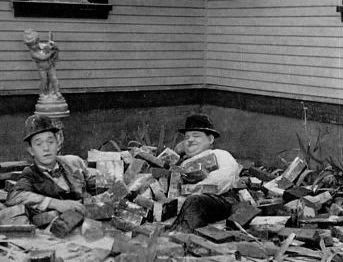 Back to basics in terms of plot, if not comedy, Hog Wild sees Stan help Ollie fix a radio aerial to the roof of his house... and nearly destroy the house as a result. One particularly notable element of Hog Wild is how much the use of breaking the fourth wall is implemented, particularly in the opening scene. One thing virtually unique to Laurel and Hardy's universe is that characters will often acknowledge the audience, most famously with Hardy's slow burns after Stan has left him exasperated. But here both Hardy and his wife repeatedly look in askance at the viewers, allowing them into their private thoughts. Where often these glances to camera are asides, having no real bearing on the main action, here Hardy allows us to become part of the narrative by letting us collude with him over his 'missing' hat. The reality is that Hardy has had his hat on his head for the entire scene without realising, and has been shouting at his wife for mislaying it without reason. When he finally becomes aware of this, he gives us a sheepish grin and places the hat behind his back, allowing us to become co-conspirators in his next act of foolishness. Also striking are the ambitious attempts during the climax to overdub sound over the action. Though Laurel and Hardy's cries of anguish don't quite match up with their stand ins and themselves performing road-based stunts, it's a commendable attempt at pushing the envelope further. Made under the working title 'Hay Wire', the short was released in Britain under the title 'Aerial Antics'.     (May 1930, 30m) Director: James Parrott Released: MGM, September 6, 1930 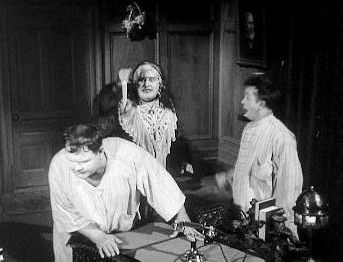 Shortly before work was to begin on The Laurel-Hardy Murder Case Stan's first wife had given birth to a son, Stanley Robert Jefferson. Born two months premature, the baby died on the 16th of May aged just nine days old. Such deeply distressing personal circumstances are hardly the basis for producing good comedy, and in this unusually macabre, death-obsessed Laurel and Hardy three reeler Stan looks drawn throughout. As with previous entries that used horror as a genre, such as Habeas Corpus, it unfortunately encourages the two leads to go unusually over the top, and a series of running and screaming unfolds. Concluding the film as a dream sequence only makes it feel like something of a cop out, and the whole thing was more successfully done when they reworked it as Oliver The Eighth two-and-a-half years later. However, while The Laurel-Hardy Murder Case may give viewers short shrift in terms of genuinely inspired comedy, it does once more up the ante in terms of scripted lines. Whereas all of the Laurel and Hardy films under Hal Roach have lines made funny by virtue of them being said by the leads, Murder Case has scripted witticisms and structured verbal gags, rather than just lines to punctuate the action, as in the early case of sound. Initially we get proof of Hardy's assertion that there's nothing funnier than a dumb man who doesn't realise he's dumb, with his rejoinder to Stan's 'Three million dollars. Is that as much as a thousand?' ('Why, man alive, it's twice as much!') There's also a nice routine on Stan having an Uncle that was hanged. Though most famously of all, this is the film where Hardy first utters the immortal 'here's another nice mess you've gotten me into me!' It can only be presumed that when the film was released in September 1930 it got a big laugh as it was used again in their next film and inspired the name of the next short, Another Fine Mess. By the time the team came to make Chickens Come Home-, just seven months later, it had already become such a familiar part of their lexicon that Stan can pre-empt Ollie and say it for him ('Well -' 'Here's another nice mess I've gotten you into.') Yet despite the phrase later being resurrected and crossing over into the Fox movies, after four films it was initially abandoned altogether. After Chickens Come Home- there's nearly a two-year period where it never gets said, before returning in Their First Mistake. That follows nearly another year of dormancy before it gets resurrected once more in Sons of the Desert and hereafter follows as a semi-regular catchphrase, with the occasional rejigging of the phrase ('Well here's another nice kettle of fish you've pickled me in' in Thicker Than Water and 'here's another nice bucket of suds you've gotten me into' in Saps At Sea). In all it only gets said in thirteen (around a quarter) of the Hal Roach sound films and is nowhere near as prominent as its reputation would suggest. Of note with the foreign language versions of The Laurel-Hardy Murder Case is that Berth Marks was partially recreated in order to increase the running time. However, the actual scene in the berth itself was the original Berth Marks footage overdubbed by Stan and Ollie, rather than refilmed. As technology was catching up with cinema, allowing dubbing to become more viable, the alternate language versions were discarded after five more pictures and native speakers would dub Laurel and Hardy for their respective countries.    (May-July 1930; September-December 1930, 65m) Director: James Parrott Released: MGM, August 15, 1931 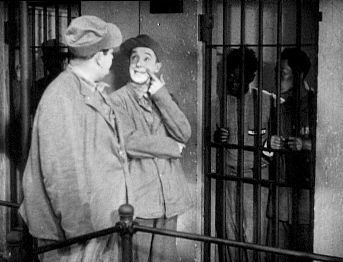 With retakes and new scenes filmed from September-December 1930, Laurel and Hardy's first feature film was finally released in August 1931. Produced under the working title 'The Rap', and then later 'Their First Mistake', Pardon Us was reputedly produced as a short and then expanded to feature length to claw back the costs hiring the prison sets. Those sets came from MGM's 1930 prison drama The Big House, spoofed here as Stan and Ollie get imprisoned due to selling alcohol to a policeman. The film continues in this vein, reworking previous material (such as the dentist scene from Leave 'Em Laughing) and adding new pieces to build a traditional Laurel and Hardy tale to full length. One of the weakest of their thirteen Hal Roach features (though I'd still take it above half a dozen of them), Pardon Us can be episodic and suffer from an 'anything for a laugh' mentality (particularly in a class scene with James Finlayson) and some of the gags involved are slightly below the standard of what we've come to expect from Laurel and Hardy at this stage. That said, there are other sequences and dialogue passages that are up there with the best of their work and the story does feel more like a traditional Laurel and Hardy work in comparison with their later operettas. With Pardon Us now eighty years old, it's a reminder that Laurel and Hardy films were made in a different age, where attitudes towards humour were different to the modern day. Although the advent of post-modernism in contemporary cinema has seen race being used as a means of comedy once more, seeing Stan and Ollie in blackface during this picture can be shocking for modern audiences. Although none of the black performers in the scene with them are demeaned or insulted, it's hard not to be a little shocked to see Stan and Ollie replacing their 'black' body paint with mud or oil, or Stan, trying to keep incognito in front of the prison governor, calling Hardy 'Oliver' then changing it to 'Sambo'. In an age where a mixed race President governs America it's difficult to watch today, and it's somewhat offensive to assume that anyone would think that Stan and Ollie - complete with white lips - could be mistaken for genuine black people. And although the black performers in the film are treated with respect, they're still portraying racial stereotypes, happily picking cotton without a care and then singing in the evening. It's difficult to determine what Laurel and Hardy's real-life racial attitudes were. Hardy's familiarity with slaves would have been from birth: his grandfather was listed as owning nine slaves on his thirteen acre property. Whatever Hardy's impressions of growing up in a segregated south, he chose to marry a Jewish girl at aged 21, so we can assume that he at least chose to disregard such conventions, if not outright defy them. As for Stan then it's safe to assume that the actor simply wasn't aware of the full implications behind such matters. Britain was a country that still had televised minstrel shows until the 1970s and Stan had, in his pre-film career, appeared in pantomime as a golliwog doll. Stan described his role in 1957 dressed as '... a big black fuzzy wig, blackface with big white eyes and white mouth, just like a rag doll.' In detailing this, there's never any implication that Stan associated the concept of a golliwog doll with being racially mocking, or indeed that the idea had ever occurred to him. There is a mildly satirical subtext to such events, too: Stan mistakenly believes two racial minorities in the prison are 'Amos and Andy'. Amos and Andy was a popular radio series that had begun two years earlier, where two white actors portrayed stereotypical black men. The series was so popular that in October 1930 a feature film, with the actors in blackface, was released. (Coincidentally a later Amos and Andy TV series in the 1950s was produced at the Hal Roach studios). As well as French, German and Spanish versions (see the entry on Berth Marks), Pardon Us was the only Laurel and Hardy movie to be remade in Italian. Although an Italian version of Night Owls - Ladroni - was known to have existed, it is believed that the particular short was the Spanish version redubbed. The Italian Pardon Us, known as Muraglie, featured Laurel and Hardy recreating the original feature by speaking phonetic Italian. Sadly, both Italian language versions are missing films. Contained in those films, and initially removed from the English language version was another troubling scene: Stan and Ollie trying to rescue the Governor's daughter from a fire as 'Tiger', a brutal inmate (played by Walter Long) attempts to rape her. Long's appearance in the 56 minute theatrical release was as an amusing foil to the boys, playing an over the top menace to their intimidated fellow cons. However, with the additional footage reinserted on DVD releases it gives the film a nastier edge. (Coincidentally Long also had his own blackface moment when he appeared in the controversial 1915 film The Birth of a Nation) Cut completely from the film and no longer existing were scenes where Stan reveals that he's kept their mug shots as souvenirs, and a scene set n the future where a bearded Laurel and Hardy tell some children the story of how they ended up in jail, rendering the entire film as a flashback. Finally, this was the first film in which Hardy uses his middle name of Norvelle, misspelt 'Norval' on the wanted posters. Although it was, in fact, his real name, he had long since adopted 'Oliver' as his first name in tribute to his deceased father.    (September 1930, 28m) Director: James Parrott Released: MGM, November 29, 1930 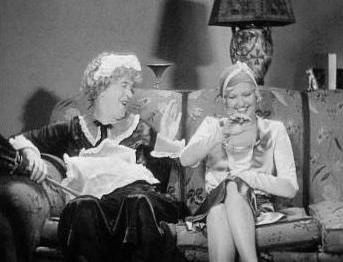 The film that cemented Hardy's 'another nice mess' catchphrase as one that would be forever misquoted. This is the third in as many films where Ollie says 'nice mess' and the only character to have actually said 'fine mess' in the series was Stan, via the use of title cards, in 1927's silent Sugar Daddies ('- -A Fine Mess You've made of things! - -') Due to the title of this three-reeler the phrase has gone down in infamy alongside the likes of 'Play it again, Sam' and 'You dirty rat!' as catchphrases that were never actually said in the movies. In fact, 'another fine mess' became such a well-known phrase that in 2004 Virgin Trains were offering first class customers complimentary cleaning tissues with the phrase adorning the packaging. Not only that, but I stupidly named this site after the misquote. As for the film itself, then I've perhaps been a little too hard on it in the past. It doesn't quite justify the extra reel, and I've always found the 'zany' ending a little too forced, but there's some nice moments, especially when Stan's deliberately trying to break Thelma Todd up with his ad-libbing. Sadly the view of Another Fine Mess being 'okay' wasn't one that was shared by Stan's dad. Interviewed by Picturegoer Weekly in January 1932 he was heavily critical of Stan's style in general and this film in particular: 'Although [Stan] is soaring in salary and popularity, I would tell you that there is much more in him than the films have brought out of him as yet. He has that humour that makes you cry. [...] But that form of humour - which is the best, I think, humour being very near to pathos - has never been brought out fully in his films. [...] I feel then that I want to dash right up to the screen and say. "Stan, Stan ..." as if my encouragement could help him to break away from the "book" a little and give us a bit more of what England wants and a little less of what America expects. [...] I sent him a little sketch of my own, which they filmed under the stupid title of "Another Fine Mess", and I didn't like the American angle they got on it one bit.'    (October/November 1930, 28m) Director: James Parrott Released: MGM, February 7, 1931 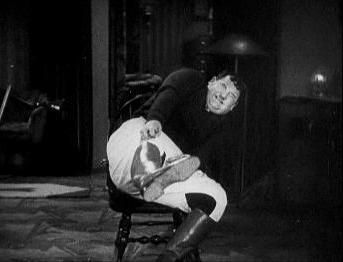 Repetition is a stock in trade of Laurel and Hardy, whereby Ollie's annoyance at Stan's inability to master even simple tasks is shared by the viewer for comic effect. However, with the three-reeler Be Big! then even Stan and Ollie are hard pressed to make taking off a boot for fifteen minutes funny. Produced under the working title 'The Chislers' it's one that even Stan was reputed to have thought went on too long, and is, for my money, probably the worst thing they did for Hal Roach, with the possible exceptions of the twee The Chimp and Babes In Toyland. A notable mistake in the film is that the 'radiator' under the window is clearly a prop, as it moves several times when Stan leans against it.   (December 1930/January 1931, 30m) Director: James Horne Released: MGM, February 21, 1931 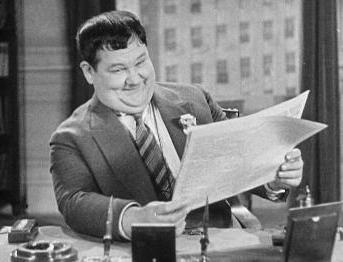 A remake of Love 'Em And Weep from four years earlier, with Hardy taking the role of James Finlayson's character and Finlayson recast as Hardy's butler. If this one's never perhaps out-and-out hilarious, it's at least consistently amusing, and a solid effort in their mid range of shorts. Like all of their three-reelers there's a case to be made that the runtime is a little too long, but Chickens Come Home- stands up pretty well regardless. The Spanish version of the picture, Politiquerias, featured two novelty acts to increase the runtime further - Mexican magician Abraham J. Cantu and professional regurgitator Hadji Ali. Both acts are highly impressive, and Ali's in particular - drinking 54 glasses of water in constant succession, then spitting the whole lot out into a bucket - has to be seen to be believed. But they do take the film down into a narrative cul-de-sac whereby the actual plot is put on hold for nearly seventeen minutes to make it feature length. One last thing... the hyphen after the title, as seen above and used elsewhere on this site. It's actually the way the film is titled on screen, and is reproduced here purely in the name of pedantry.   
|
||||||||||||||||||||||||||||||||||||||||||||||||||||||||||||||||||||||||